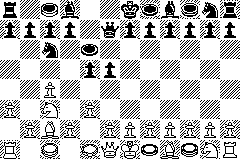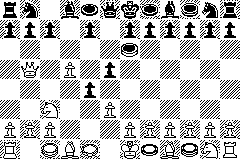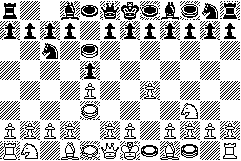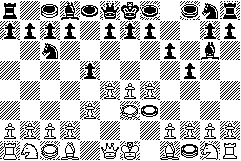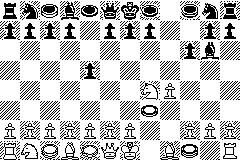Variant Chess Index
|
The magazine to broaden your chess horizons
|
Contents
|
Postal Chess OrganiserOur advertisement for a Postal Chess Organiser recently has received a gratifyingly swift response from Jed Stone. His enthusiasm and previous experience should lead to a significant expansion of our service to readers. I get the impression that there is a steady demand for postal play in a number of variants which we should now be in a position to supply. Jed is at present contemplating the exact form that this should take, and welcomes ( indeed, encourages) input from the 'customers' to help him in this task. For more information please read his article on page 94. I hope to make an article from Jed a regular feature, which he intends to supplement with a newsletter in between issues. ReviewThe Five Dances of Huashan This a well produced A5 booklet of fifty two pages by Shu Ming Li and C. K. Lai. It contains one hundred and eight problems in Chinese Chess ( XiangQi ) and is published in a limited edition of one hundred. I am pleased to see that it is bi-lingual ( Chinese and English ) throughout - introduction, comments and solutions. I have looked at a fair sample of the compositions and think the overall quality is excellent. The title piece, in particular, is a real cracker: All aspiring XiangQi players should have it. Published by
|
||||||||||||||||||||||||||||||||||||||||||||||||||
|
Modern Courier Chess by Paul Byway The layout of MCC and the powers of the extra pieces (significantly less powerful than those met with in the previous article - in VC37) are given below.
You can experiment with the original Courier Game in a more coherent form by replacing the queen here with a mann (has the same move as a king). Any piece that moves only one step at a time, that is a pawn, fers, king or (see previous sentence) mann, is able, if unmoved, to move two steps in one turn - but not to capture. Pawns are subject to en passant capture and there is no castling. One neat feature is that each courier covers a quarter of the board: only a courier created by promotion can be exchanged for an opposing courier. The Opening in MCC The aim, I must suppose, is to develop the pieces rapidly and efficiently: not a straightforward task. But more than this, if we carry over our Chess experience, it is necessary to control the centre. Two questions immediately arise: (1) What is the centre? and (2) Does our Chess experience indeed carry over: must the centre be controlled? (The answer might be no, if we judge by the campaigns of Alexander the Great). I hope you don't expect me to provide an answer: all I can hope to do is explore some possibilities. My definition of the centre, by the way, is that group of twelve squares on which a bishop has its greatest range, which is the large square from e3 to h6 minus the the four corner squares. In opening your game you have a much wider choice than in Chess. I classify openings as follows:- classical (e4 e5) and knightsmove (f4 h5 or f4 d5). I assume that these are the most important, although there are many others. As an instance one of the best replies to 1.e4 seems to be 1. ..i6. The choice of 1.e4 looks natural, developing as it does the queen and bishop: the pawn blocks the opposing bishop but is itself an object of attack. Another promising move, 1.d4 has not yet had the attention it deserves. It opens the square d2 for both knight and fers: 2.Nc3, 3.e4 looks like a natural follow-up. The central moves 1.f4 and 1.g4 have been largely neglected - and this is probably unfair. In what follows I give some initial impressions of each opening, lightly following a likely line. There must be big improvements at many points. If you find any major and obvious howlers please let me know. Let me know anyway if you think you have developed a better line!
|
1.c4 e5 2.Bc2?! f5 3.e3 Nc6 4.a3 Fe6 5.Nc3 Qf7 threatens both 6...d5 and 6...Qxk2.
1.d4 d5 ( or ...f5) This system seems to be particularly rich
2.e4 dxe4 3.Nc3 f5 ( or ...e6 4.Nxe4 f5 5.Nc5) 4.f3 Ce6 ( or ...exf3 5.Bxf3 c6) 5.d5 Cg6 6.Qb5
1.e4 e5 ( or ...g5, ...i6) 2.Ce3 Nc6 3.Nj3 Ce6 4.h4 with a possible follow up of i3, Fh3 and Ki2 if necessary.
This line illustrates my earliest thoughts on the opening - twin strongpoints at e4 and h4 muffle the black bishops.
|
|
Modern Courier Chess
1.f4 f5 ( or ...d5, ...h5) 2.g4 fxg4 3.h3 ( or 3.e4 Ce6 4.Nc3) gxh3 4.Cxh3 As an illustration of the richness of the game, here is a long and speculative line which follows White's attempt to regain the pawn on e4. 1.f4 f5 2.e4 fxe4 3.Nc3 Cc6 4.b4 a6 5.a4 g6 6.b5 axb5 7.axb5 Rxa1 8.Cxa1 Ce6 9.g4 h6 10.f5 (Ch3!?) gxf5 11.gxf5 Qxf5 12.Qxf5 Bxf5 13.Bxj7 Nl6 14.Bi6+ Bh7 15.Bxh7+ Kxh7 16.Ke3 (the king's leap).
I think that Black is better here, but the important point is that despite the wholesale slaughter the position remains rich in plans and possibilities. An unresolved problem concerns the material balance if White exchanges his knight for the courier in regaining the pawn. At this stage I believe the knight is worth slightly more than the courier. 1.g4 g5 ( or ...e5) 2.f4 gxf4 3.e3 ( or Qxf4) fxe3 4.Cxe3 White is prepared to offer a pawn for development. Offering a pawn like this might be a better idea than in Chess if the loss matters less - or a worse, if the defensive resources are greater. Just recently an experiment with 1.g4 proceeded as follows: 1.g4 e5 2.e3 i6 3.f4 Nc6 4.Fg3 j5 5.h4 Bk6 6.Fh3
After a few more moves it was agreed that White had been given too free a hand in the centre. My fellow explorer Roy Talbot likes to leave the pawns in front of his king alone, and prefers to advance on the flank. The next trial improved with 1.g4 e5 2.e3 i6 3.f4 exf4 4.exf4 j5 5.Nc3 k5 6.l4 My own view is that, with so many minor pieces round my king, opening up in the centre is surprisingly safe. At any rate I haven't been dissuaded from it yet.
|
1.h4 h5 ( or ...e5, ...f5) 2.e4 Nj6 3.Nc3 e5 Black is happy to offer the e-pawn for the h-pawn in order to uncover White's king
1.i4 i5 ( or ...e5, ...f5, ...g5, ...i6) 2.Nj3 j6 ( or ...g6) 3.h4 ( or g3) ixh4 4.Nxh4 Bk6 5.Fh3 e5 I can't say that I trust this line where White opens up his own king's position. Incidentally, there is a tactic buried in the initial layout. In some positions it may be possible to play ...Bd8xj2 and answer Bi1xj2 with ...Qf8-j4+ and ...Qj4xj2.
1.j4 g5 2.Nl3 f5 3.i3 Nj6 4.Fj3 Fg6 5.k4
These last two opening ideas betray the influence of Roy Talbot's preference for flank play. Here ...Nj6 creates a target for the advancing pawns and might be improved on. Another approach for Black is 1.j4 e5 2.i3 i6 3.Fj3 Ni7 4.k4 h5. The move i3(i6) defends the king and opens a path for knight and fers. 1...i6 may be Black's best move. |


